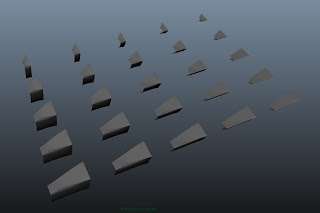Project 1C Readings.
Marc Angélil postulates in his writing "Inchoate: An Experiment in Architectural Education" that we have embarked on a period in time in which we must challenge the way we proceed in architectural education. Is there a scenario that we can perhaps unlearn what we have learned about classical approaches to education. "Every presumed totality, including architecture, is also formed by what it excludes." Architecture is a discipline in which we fail to include a wealth of knowledge from other fields that could begin to evolve a way of thinking. The "unexpectedness" of a new, unfamiliar way to generate creativity could lead to a whole new era of architectural education.
There's merit in stepping out of tendency and begin to think more freely. The potential for growth spawned from this free thinking is exciting and will allow for growth. This is a unique approach but perhaps not totally unheard of previously. The renaissance architects of old had much more range to explore various ways to dissect and analyze ways of thinking. There wasn't a set template on how to "properly" design. They were establishing a base by which we have generally remained true to through the 20th century. However, as technology has progressed rapidly, our approaches have not. Why is that? If we are so forward thinking in a design sense, trying to innovate in designs, why can't we innovate in our approach to design?
This article led well into the introduction written by SHoP Architects "Versioning: Evolutionary Techniques in Architecture." SHoP has taken much of what Marc Angélil argues and applies it in a professional practice of architecture. 2D, image based projections of space creation are no longer valid. We need to start focusing on technologies that are vector based in nature and much more prescribing of the various intricacies of the forms we create. Perhaps, also, streamlining a manufacturing process during construction.
My only worry about such a process is this: if so many building materials and specs will be project-specific, how will this affect productivity of manufactured goods? If most new construction becomes one-off designs, it will slow projects down and make most materials difficult to fabricate and yield a higher end cost. We often compare the new design/build process with the use of modeling to car production. However, car production is highly different in the sense that a specific model is replicated repeatedly, thus yielding a higher benefit for one-off materials. In a building, the designs we generate are very much project specific and most likely will not be replicated beyond the project. So, as architects, I believe it is our duty to utilize the modeling tools we have to perfect the system of construction today by not prescribing unnecessarily convoluted design components, but perhaps design with a mind towards efficiency of materials and eliminating waste. Maybe we can model so precisely that we can accurately determine gypsum board counts, sheathing count, cladding pallets, etc...
Marc Angélil postulates in his writing "Inchoate: An Experiment in Architectural Education" that we have embarked on a period in time in which we must challenge the way we proceed in architectural education. Is there a scenario that we can perhaps unlearn what we have learned about classical approaches to education. "Every presumed totality, including architecture, is also formed by what it excludes." Architecture is a discipline in which we fail to include a wealth of knowledge from other fields that could begin to evolve a way of thinking. The "unexpectedness" of a new, unfamiliar way to generate creativity could lead to a whole new era of architectural education.
There's merit in stepping out of tendency and begin to think more freely. The potential for growth spawned from this free thinking is exciting and will allow for growth. This is a unique approach but perhaps not totally unheard of previously. The renaissance architects of old had much more range to explore various ways to dissect and analyze ways of thinking. There wasn't a set template on how to "properly" design. They were establishing a base by which we have generally remained true to through the 20th century. However, as technology has progressed rapidly, our approaches have not. Why is that? If we are so forward thinking in a design sense, trying to innovate in designs, why can't we innovate in our approach to design?
This article led well into the introduction written by SHoP Architects "Versioning: Evolutionary Techniques in Architecture." SHoP has taken much of what Marc Angélil argues and applies it in a professional practice of architecture. 2D, image based projections of space creation are no longer valid. We need to start focusing on technologies that are vector based in nature and much more prescribing of the various intricacies of the forms we create. Perhaps, also, streamlining a manufacturing process during construction.
My only worry about such a process is this: if so many building materials and specs will be project-specific, how will this affect productivity of manufactured goods? If most new construction becomes one-off designs, it will slow projects down and make most materials difficult to fabricate and yield a higher end cost. We often compare the new design/build process with the use of modeling to car production. However, car production is highly different in the sense that a specific model is replicated repeatedly, thus yielding a higher benefit for one-off materials. In a building, the designs we generate are very much project specific and most likely will not be replicated beyond the project. So, as architects, I believe it is our duty to utilize the modeling tools we have to perfect the system of construction today by not prescribing unnecessarily convoluted design components, but perhaps design with a mind towards efficiency of materials and eliminating waste. Maybe we can model so precisely that we can accurately determine gypsum board counts, sheathing count, cladding pallets, etc...



















